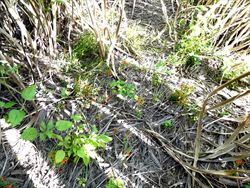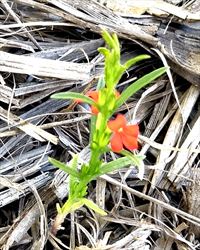Click on images to enlarge

infestation (photo: Biosecurity Queensland)

infestation (photo: Biosecurity Queensland)

habit (photo: Biosecurity Queensland)

leaves and flower (photo: Biosecurity Queensland)
Scientific Name
Striga asiatica (L.) KuntzeSynonyms
Striga lutea Lour. (misapplied)
Striga coccinea Benth. (synonym)
Buchnera asiatica L. (basionym)
Family
Orobanchaceae, previously in Scrophulariaceae
Common Names
red witchweed
Origin
Species of Striga are native to tropical parts of Africa and Asia.
Naturalised Distribution
One occurrence only in Australia, near Mackay. Not currently considered to be naturalised in Australia. Widespread globally.
Habitat
Red witchweed is best suited to dry, tropical areas, but has been recorded from a range of climate zones including subtropics and warm temperate regions. It is a major pest parasitizing grasses and cereal crops such as maize, sorhgum, rice and sugar cane.
Habit
Annual herb to 40 cm tall.
Distinguishing Features
Red witchweed grows 10-40 cm tall and has leaves arranged in opposite pairs at the base of the stem and alternate in the upper part
The leaves are 6-40 mm long and 1-4 mm wide and have a tapered pointed tip
The flowers are 5-10 mm in diameter and are usually bright red but can be white, yellow or pink
The calyx (green sheath enclosing base of flower) has 10 longitudinal ribs (native species of Striga only have 5 ribs)
Stems and Leaves
Stems are bright green, roughly hairy and squarish in cross section. Leaves are opposite one another at the base of the stem and alternating further up. Leaves are linear, 6-44 mm long and 1-4 mm wide and taper to a point.
Flowers and Fruit
Flowers are commonly bright red, 10-16 mm long and 10-12 mm in diameter. Yellow, pink and white flowering plants have been recorded overseas by only red flowered plants have been detected in Australia.
Reproduction and Dispersal
Red witchweed produces thousands of very small, dust-like seeds which can remain viable in the soil for 15 years. They germinate after rain and when in close contact with the roots of a suitable host plant.
Environmental Impact
A potential pest of grasslands across northern Australia.
Other Impacts
Red witchweed is a major pest of cereal crops globally and is considered to be a significant threat to Australia's grain production and exports.
Legislation
Red witchweed is a declared pest in all Australian States.
Management
Early detection and eradication is the best way to prevent red witchweed from becoming established. Suspected occurrences should be notified to authorities immediately. Plants should not be moved or touched as the dust-like seeds can spread on clothing, machinery and other items.
Similar Species
Native species of Striga are distinguished by having only 5 longitudinal ribs on the calyx (green sheath at base of the flower) are (usually) pink, purple or white flowers.
Other exotic Striga species that are also potential pests are S. hermonthica (5 calyx ribs, flower tube bent half way along) and S. gesnerioides (5 calyx ribs but lacking expanded leaves - a true parasite).

